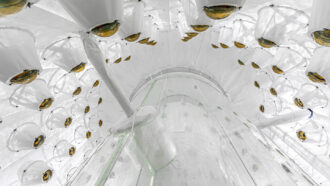The next generation of dark matter detectors has arrived.
A massive new effort to detect the elusive substance has reported its first results. Following a time-honored tradition of dark matter hunters, the experiment, called LZ, didn’t find dark matter. But it has done that better than ever before, physicists report July 7 in a virtual webinar and a paper posted on LZ’s website. And with several additional years of data-taking planned from LZ and other experiments like it, physicists are hopeful they’ll finally get a glimpse of dark matter.
“Dark matter remains one of the biggest mysteries in particle physics today,” LZ spokesperson Hugh Lippincott, a physicist at the University of California, Santa Barbara said during the webinar.
LZ, or LUX-ZEPLIN, aims to discover the unidentified particles that are thought to make up most of the universe’s matter. Although no one has ever conclusively detected a particle of dark matter, its influence on the universe can be seen in the motions of stars and galaxies, and via other cosmic observations (SN: 7/24/18).
Located about 1.5 kilometers underground at the Sanford Underground Research Facility in Lead, S.D., the detector is filled with 10 metric tons of liquid xenon. If dark matter particles crash into the nuclei of any of those xenon atoms, they would produce flashes of light that the detector would pick up.
The LZ experiment is one of a new generation of bigger, badder dark matter detectors based on liquid xenon, which also includes XENONnT in Gran Sasso National Laboratory in Italy and PandaX-4T in the China Jinping Underground Laboratory. The experiments aim to detect a theorized type of dark matter called Weakly Interacting Massive Particles, or WIMPs (SN: 12/13/16). Scientists scaled up the search to allow for a better chance of spying the particles, with each detector containing multiple tons of liquid xenon.
Using only about 60 days’ worth of data, LZ has already surpassed earlier efforts to pin down WIMPs (SN: 5/28/18). “It’s really impressive what they’ve been able to pull off; it’s a technological marvel,” says theoretical physicist Dan Hooper of Fermilab in Batavia, Ill, who was not involved with the study.
Although LZ’s search came up empty, “the way something’s going to be discovered is when you have multiple years in a row of running,” says LZ collaborator Matthew Szydagis, a physicist at the University at Albany in New York. LZ is expected to run for about five years, and data from that extended period may provide physicists’ best chance to find the particles.
Now that the detector has proven its potential, says LZ physicist Kevin Lesko of Lawrence Berkeley National Laboratory in California, “we’re excited about what we’re going to see.”


